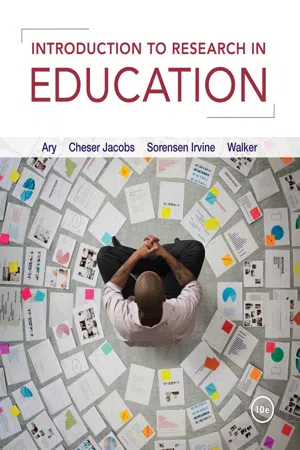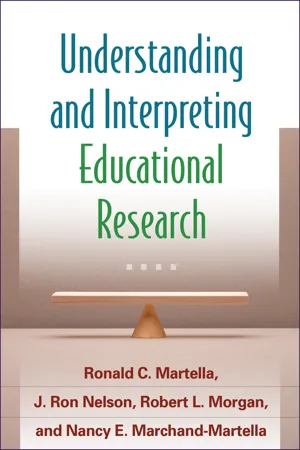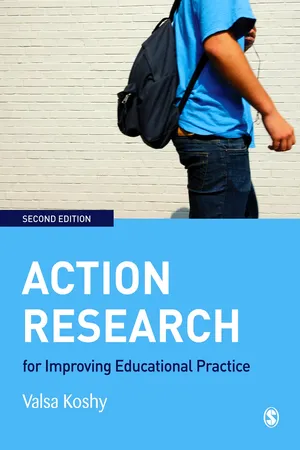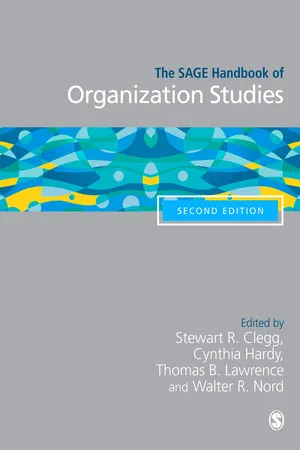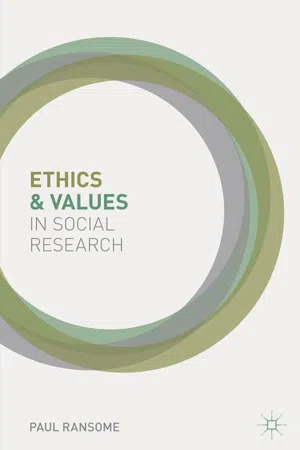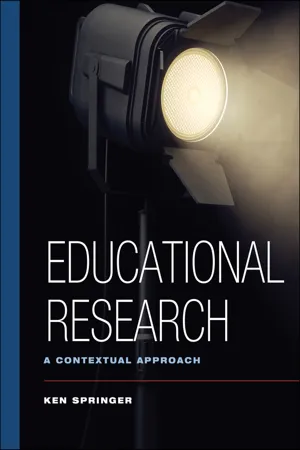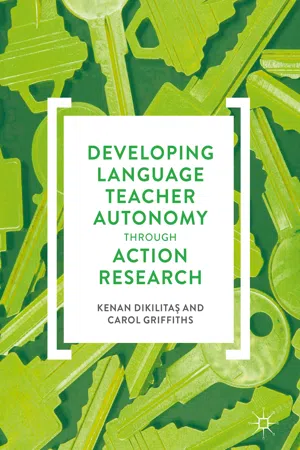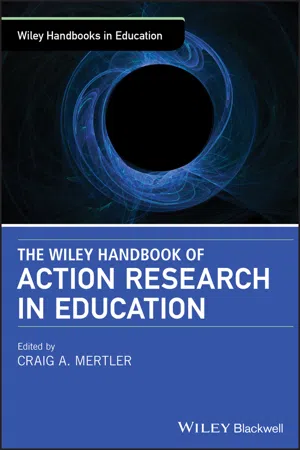Business
Action Research
Action research in business involves a systematic approach to problem-solving and decision-making. It emphasizes collaboration between researchers and practitioners to identify and address organizational challenges. This iterative process allows for the development and implementation of practical solutions while generating valuable insights for continuous improvement.
Written by Perlego with AI-assistance
Related key terms
1 of 5
11 Key excerpts on "Action Research"
- eBook - PDF
- Donald Ary, Lucy Jacobs, Christine Sorensen Irvine, David Walker(Authors)
- 2018(Publication Date)
- Cengage Learning EMEA(Publisher)
Action Research starts, as does all research, with a problem to be solved. However, the problem may not be well defined and is often referred to as a “focus” rather than a problem. The key difference is in the primary purpose of Action Research, which is to take action to solve a local problem or to improve a practice. It is not intended to create theories or to be generalizable. Action Research is a practical tool for solving problems experienced by people in their professional lives. It is empirical insofar as it requires people to define and observe the phenomena under investigation. Action Research uses the methods, procedures, and concepts associated with both quantitative and qualitative research. Although Action Research involves systematic inquiry, it has some distinctive characteristics that bear consideration. Table 20.3 compares typical Action Research with the more formal traditional approaches to research you have studied in this textbook. Table 20.2 Approaches to Action Research Approach Who’s Involved Purpose/Goal Collaborative Action Research Involves multiple researchers. In education, this may include school and university personnel or teachers and school administrators. To share expertise and foster dialogue among stakeholders Critical Action Research Involves wide collaboration. In education, this may include university researchers, school ad-ministrators, teachers, and community members. To evaluate social issues and use the results for social change Classroom Action Research Involves teachers in their classrooms; can involve groups of teachers examining common issues. To improve classroom practice or to improve practices in the school Participatory Action Research Involves collaboration among stakeholders in a social process. - Ronald C. Martella, J. Ron Nelson, Robert L. Morgan, Nancy E. Marchand-Martella(Authors)
- 2013(Publication Date)
- The Guilford Press(Publisher)
When we realize that our values can and do affect how we see the world, we can take these values into con- sideration when interpreting research results. This realization is important for teachers and practitioners. Perhaps more important than any- thing else, Action Research can help practitioners understand their values and how these values affect what they are doing. Contextual Focus Action Research is also context-bound: It occurs in the real world and addresses real-life prob- lems or situations. The problems or situations to be addressed in Action Research are defined by those who are already a part of the context, such as classroom teachers. Action Research- ers set out to solve a problem or to answer a research question, then attempt to fit the solu- tion or answer within a theory. This sequence of events is the reverse of much of quantitative research, in which theory is developed first and research is an attempt to verify predictions based on the theory. The ultimate outcome of Action Research is the process through which the Action Researcher must go to obtain a solution. The gathering of data allows Action Researchers to learn more about their settings, students/par- ticipants, and themselves. Change‑Based data and Sense Making The data collected in Action Research are obtained in a systematic fashion, similar to that of researchers conducting field research. The goal for Action Researchers is to generate the data, then make interpretations, with the ulti- mate goal of making changes in their practice. Thus, the manner in which the data are collected must be logical and follow accepted methods of data gathering. For example, if Action Research- ers are using qualitative methods, triangulation should be obtained. After the data are collected, Action Researchers should relate the findings to a theory or theories, in much the same manner as conventional qualitative researchers.- eBook - ePub
Action Research for Improving Educational Practice
A Step-by-Step Guide
- Valsa Koshy(Author)
- 2009(Publication Date)
- SAGE Publications Ltd(Publisher)
Educationists in different roles – teachers, policy makers and administrators – see the potential of Action Research in producing applied knowledge in a number of applied contexts which can be of practical use. An increasing number of papers based on practitioner research are being presented at international research conferences. There are several websites and practical networks, such as CARN (see the websites mentioned at the end of this chapter) which provide forums for those interested in Action Research as a methodology, as well as the existence of international journals, such as Educational Action Research (once again, see the relevant website at the end of this chapter). What is involved in Action Research? Research is about generating knowledge. Action Research creates knowledge based on enquiries conducted within specific and often practical contexts. As articulated earlier, the purpose of Action Research is to learn through action leading to personal or professional development. It is participatory in nature which led Kemmis and McTaggart (2000: 595) to describe it as participatory research. These authors maintain that Action Research involves a spiral of self-contained cycles of: planning a change; acting and observing the process and consequences of the change; reflecting on these processes and consequences and then replanning; acting and observing; reflecting; and so on … Figure 1.1 illustrates this spiral model of Action Research proposed by Kemmis and McTaggart, although the authors advise us against using this as a rigid structure. They maintain that in reality the process may not be as neat as the spiral suggests - eBook - PDF
- Stewart R Clegg, Cynthia Hardy, Tom Lawrence, Walter R Nord, Stewart R Clegg, Cynthia Hardy, Tom Lawrence, Walter R Nord(Authors)
- 2006(Publication Date)
- SAGE Publications Ltd(Publisher)
Introduction Since its inception in the middle of the 20th century, Action Research has gradually gained in prominence. In the last few years, however, there has been an explosion of interest and a concurrent abundance of articles and books about it and using it. The term is used to describe a range of approaches involving interventions in organizations that have the purpose of bringing about practical transformation and advancing knowledge. A myriad of terms and approaches are used in connection with Action Research. These include col-laborative and participatory research, co-operative, collaborative, appreciative and clinical inquiry and process consultation, process management and soft systems methodology. The field is confused and, despite the numerous attempts to differentiate the approaches (see for example, Argyris and Schon 1991; Elden and Chisholm 1993a; Schein 1995; Raelin 1997), precise interpretations of each seem largely to depend on the user or author and the audience they are playing to. In this chapter we will be presenting a particular view of Action Research as a phenomenological methodology for researching organizational processes and practices . From this perspective it naturally sits alongside ethnography (Thomas 1993; Tedlock 2000), case study research (Stake 1995; Yin 2002) and the development of grounded theory (Glaser 1992; Strauss and Corbin 1998; O’Connor et al. 2003). The distinguishing feature of this type of Action Research, as compared to these other research approaches, is an involvement by the researcher with members of orga-nizations over matters that are of genuine concern to them and over which they intend to take action. By ‘involvement’ we mean taking a role such as facilita-tor or consultant to a client or clients (or being an employee), having some influence on choices and accepting the accountability and responsibility that this implies. - eBook - ePub
- Christopher Crouch, Jane Pearce(Authors)
- 2013(Publication Date)
- Berg Publishers(Publisher)
Chapter 2 .Action Research has become a familiar tool for professionals in many settings such as business, nursing and education who want to explore possibilities for making changes to improve their practices. Because of this variety of applications, conceptions of what constitutes Action Research are diverse. Action Research designs are necessarily flexible, to allow researchers to put together a range of research strategies according to the specific needs of the research. Action Research exemplifies the importance of allowing the research questions to drive the research process. Action Research typically deals with problems that are ‘local’ (Ary, Jacobs & Sorensen, 2010, p. 516) or significant to the practitioners themselves, who then plan the research process, decide on suitable strategies, conduct the research and make decisions for action based on the research outcomes.The goal of Action Research is to develop practical and relevant solutions to the problems identified. This intention makes Action Research quite unlike other forms of research, which seek primarily to develop new theories or explanations or to produce new knowledge about phenomena in the world. The possibility for researchers themselves to own the research process and the research findings is powerful, and makes Action Research clearly distinct from forms of research where the processes are decided by ‘expert’ researchers who then own the findings and impose the solutions (Ary, Jacobs & Sorensen, 2010, p. 514). Action Research is conducted by those individuals who are most implicated in the research problem. In Kemmis and McTaggart’s words, participants in Action Research ‘live with the consequences of what they have done’ (2003, p. 376), for better or worse! The same can be said for designers. The involvement of insiders such as designer colleagues or the users of design at every stage of the research process marks Action Research as significantly different from those forms of research where a researcher from outside sits apart from the main action and remains uninvolved. - eBook - PDF
- Paul Ransome(Author)
- 2013(Publication Date)
- Bloomsbury Academic(Publisher)
Action Research thus adopts a pragmatic attitude towards the aims of the research. As Stringer puts it: ‘Action Research is a systematic approach to investigation that enables people 130 ETHICS AND VALUES IN SOCIAL RESEARCH to find effective solutions to problems they confront in their everyday lives’ (Stringer 2007: 1). Although most social researchers expect to achieve outcomes that can con-tribute both to the development of new theory and to the solution of practical problems, the emphasis in Action Research is very much on the latter. Action Researchers are often less concerned with gathering data objectively in order to tackle some abstract theoretical point of interest to other members of the academic community than with achieving more immediate resolution of a per-ceived operational difficulty and/or with trying to implement changes to create improved outcomes for practitioners and stakeholders. Action Research there-fore tends to be problem centred and problem oriented rather than taking its direction from theoretical reasoning. In this respect, an action approach might be especially appropriate in those investigative contexts in which the situation is likely to be flexible and in which outcomes have to be seen as an emer-gent property of the research process. One of the advantages of the action approach is that it might offer the only way forward in studying some varieties of social phenomena that lie beyond the reach of conventional data-gathering techniques. Adopting a more detached attitude towards theoretical commit-ments means that Action Research often has an exploratory or innovative character. The circular nature of Action Research, in which intermediate or transi-tory outcomes are continually being fed back into the process by participants (we discuss the concept of reflexivity shortly), combined with its problem-solving orientation, tends to result in a considerable foreshortening of the usual research process. - eBook - PDF
Educational Research
A Contextual Approach
- Ken Springer(Author)
- 2015(Publication Date)
- Wiley(Publisher)
Action Research often reflects an ongoing process of refinement as the practitioner seeks increasingly desirable solutions to educational problems. Although the roots of Action Research can be traced to the educational philoso- phies of John Dewey and others, the term ‘‘Action Research’’ and the basic principles of this approach were formulated by social psychologist Kurt Lewin in the 1940s. Lewin was interested in developing better methods for problem solving through group discussion and, in most general terms, the principles he outlined inform current Action Research methods. Action Research Methods Although most Action Research is qualitative, the methods used may be quantitative, qualitative, or mixed. In this section, the general sequence of steps in Action Research is outlined. This sequence, reflected in the work of Lewin, Kemmis (1994), Mills (2003), and others, consists of reflection, planning, action, and further reflection. Reflection The first step in Action Research is for the practitioner to identify a problem by reflecting on something he or she has observed in an educational setting. In the study described earlier, Villano observed that her fifth-grade class was struggling to understand their textbooks. Upon reflection, she decided that this problem is both serious and resolvable. Other kinds of problems that might give rise to an Action Research study include the following: • Social isolation on the part of an immigrant student • Poor motivation among students in a certain class • The need for a particular teacher to receive additional training • Insufficient access to vocational resources among a particular class of seniors • Discrimination against certain groups of students and families in a school district • Conflict between administrators and teachers concerning a new policy Planning Once the practitioner has identified a problem, the next step is to develop a plan of action. - Kenan Dikilita?, Carol Griffiths, Kenan Dikilita?, Kenan Dikilita?, Kenan Dikilita?, Kenan Dikilitaş(Authors)
- 2017(Publication Date)
- Palgrave Macmillan(Publisher)
1 © The Author(s) 2017 K. Dikilitaş, C. Griffiths, Developing Language Teacher Autonomy through Action Research, DOI 10.1007/978-3-319-50739-2_1 1 Introduction to Action Research What Is Action Research? 1. Since there is “action”, this implies that there will be some kind of active investigation of whatever is seen to be the problem to be fixed, the puzzle to be considered, the question to be answered, or the issue to be addressed. 2. Since there is “action”, there must be an agent, that is, someone per- forming the action. In the case of Action Research (AR), this needs to be someone who is in some way a participant in the context where the problem/question/issue/puzzle is to be investigated. For the purposes of this book, although much of it may be applied more widely (e.g. to medical or workplace environments), we will focus on educational contexts, and especially on the teacher and/or the students. Background Since the term was first used by Lewin (1946), AR has been defined in various ways over the years. Nunan (1992) provides a “minimalist definition, containing a question/issue, data, and interpretive analysis” 2 (p. 18), while Burns (2010) further explains that in AR “the teacher becomes an ‘investigator’ or ‘explorer’ of his or her personal teaching context, while at the same time being one of the participants in it” (p. 2). AR has become one of the critical strategies that teachers have engaged in for their professional development with a view to gain- ing deeper insights into classroom contexts including learners, teach- ing practices, and classroom management. Therefore, issues identified by teachers as practitioners are of great importance in that they are examples of the critical actual lived experiences that could inform poli- cymakers, teacher-educators, or academic researchers.- Craig A. Mertler(Author)
- 2019(Publication Date)
- Wiley-Blackwell(Publisher)
These are what we believe are the practices of the majority of Action Research projects and action learning programs, respectively. We believe the majority model of Action Research involves taking action aimed at both improving the situation within a social system and, by so doing, also Tom Bourner and Cheryl Brook 194 contributing to the accumulation of knowledge. It is based on the premise that trying to change a social system is an effective way of gain greater understanding of it. In other words, we can discover new knowledge about an organization or other social system by acting upon it, and that new knowledge can be preserved, disseminated, and applied like any other contribution to the pool of knowledge. Hence, Action Research provides a way of realizing the advancement of knowl-edge of social systems and the social sciences, more generally. It is usually researcher‐led, involving varying degrees of collaboration with the participants within the social system in question. We believe that the majority model of action learning is an approach to learn-ing and development based on participants tackling real problems, learning with, and from, a set of other participants who are likewise engaged in cycles of action and reflection. The starting point for action learning is the realization that first‐ hand experience can yield first‐hand knowledge (including self‐knowledge) that can help individuals contribute to tackling the problems of organizations and other social problems. The focus of action learning is on the individual partici-pant as the agent of change within an organization. The most obvious thing that Action Research and action learning have in com-mon is action. Both are action‐based, both value action as a source of knowledge, and both produce actionable knowledge.- eBook - PDF
- James Nolan, Jr., Linda A. Hoover(Authors)
- 2011(Publication Date)
- Wiley(Publisher)
The ulti- mate impact of Action Research on the school as an organization is the creation of a community of professional learners committed, individually and collectively, to examining and improving their prac- tice for the benefit of students. Action Research contributes significantly to creating the essential elements of a professional learning community: In general there are three key features of school-based professional communities: 1) Make teachers’ classroom work public for examination by colleagues; 2) institute processes of critical dialogue about classroom practices (e.g. How do we know that something is actually working?); 3) sustain collaboration among teachers that focuses on strengthening the school’s instructional system. At base there is ‘‘a professional ethic of individual and collective responsibility to improve the learning of every child.’’ (Bryk, Sebring, Allensworth, Luppescu, & Easton, 2010, p. 56) Joseph Senese, the assistant principal of High- land Park High School in Illinois, summarized the benefits of Action Research in his school. The school as an organization benefited from the creation of interdisciplinary learning teams and from the establishment of looping between disci- plines. Its culture came to be characterized by teachers engaging in frequent cross-disciplinary communication, more frequent use of data-driven decision making, and much greater sharing of best teaching practices (Senese, 2002). In addition to benefiting individual teachers and the school as an organization, Calhoun (2002) pro- vides evidence that Action Research can be beneficial to students as well. She describes a high-school collaborative Action Research project designed by faculty members who perceived that their students were not good readers. Low scores on standardized reading tests validated the teachers’ perceptions. The outcome of the Action Research project was the devel- opment of a literacy course aimed at assisting the poorest readers. - eBook - PDF
- Richard Pring(Author)
- 2010(Publication Date)
- Continuum(Publisher)
It cannot but embrace the context of teaching - the physical conditions in which learning is expected to take place, the expectations of those who determine the general shape of the curriculum, the resources available for the teachers to draw upon, the constraints upon the teacher's creative response to the issues, the scheme of assessment. It is difficult to see how the clash between the 'official curriculum' and the 'teacher researcher' can be avoided when the latter is constantly testing out the values of the teaching strategies. One can see, therefore, why the encouragement of teacher research is so often defined within official documents in a rather narrow sense. Action Research, therefore, is proposed as a form of research in which teachers review their practice in the light of evidence and of 136 Philosophy of Educational Research critical judgement of others. In so doing, they inevitably examine what happens to the values they hold, and which they regard as intrinsic to the transaction they are engaged in. Such critical appraisal of practice takes in three different factors which impinge upon practice, and shape the activities within it - the perceptions and values of the different participants, the 'official expectations and values' embodied within the curriculum, and the physical conditions and resources. To do this, various methods for gathering data will be selected -examination results, classroom observation, talking with the pupils. And the interpretation of what is 'working' will constantly be revised in the light of such data. But, of course, others too might, in the light of the data, suggest other possible interpretations. Thus, the dialogue continues. There is no end to this systematic reflection with a view to improving practice. RESEARCH? We need, however, to reflect on what would seem to be the necessary conditions for such teacher reflection to be considered as research.
Index pages curate the most relevant extracts from our library of academic textbooks. They’ve been created using an in-house natural language model (NLM), each adding context and meaning to key research topics.
